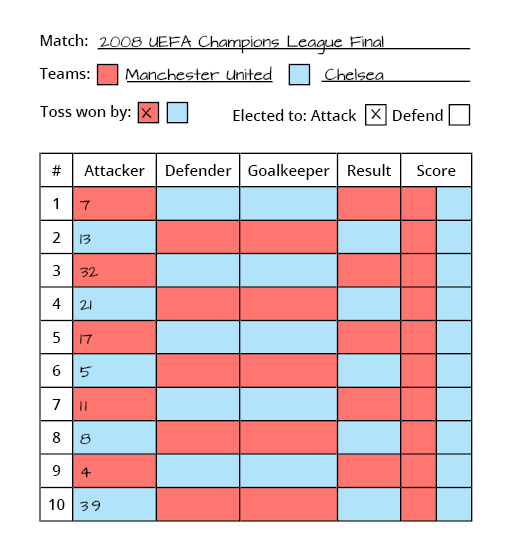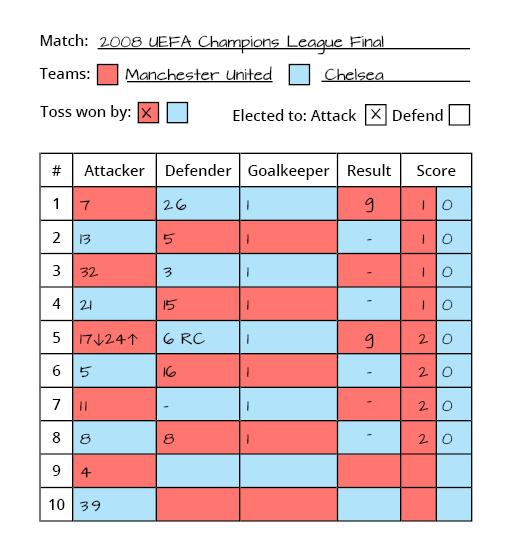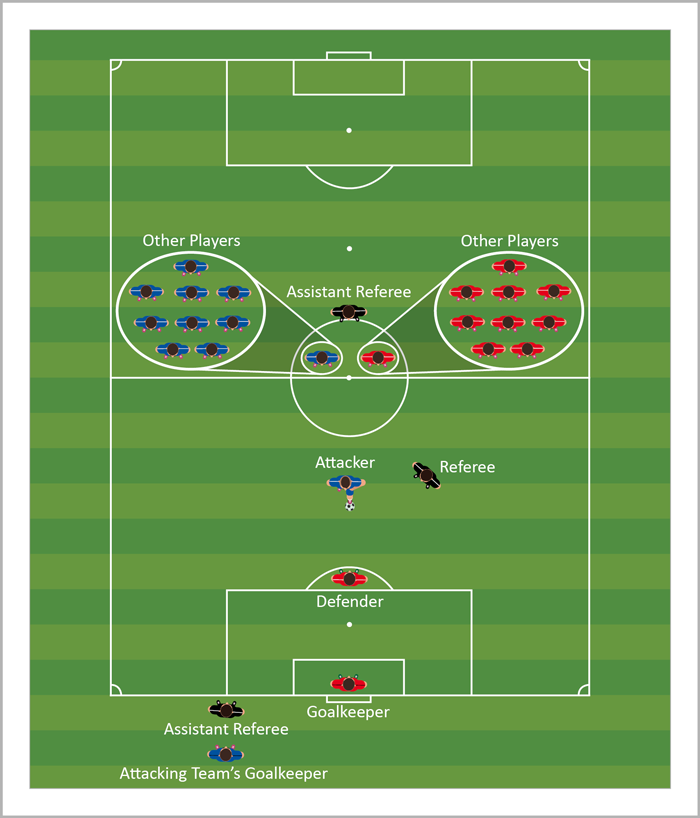Attacker Defender Goalkeeper (ADG) occurs after normal play has ended and unless otherwise stated, the relevant Laws of the Game apply. Warnings and cautions issued during normal play are carried forward into ADG.
Procedure
Before ADG starts
- Unless there are other considerations (e.g. ground conditions, safety etc.), the referee tosses a coin to decide the half of the field where ADG will take place, which may only be changed for safety reasons or if the goal or playing surface becomes unusable.
- The referee tosses a coin again and the captain of the team who wins the toss, decides whether to attack or defend in the first contest.
- If at the beginning of ADG one team has more players on the field than the other, they maintain that advantage.
- The referee meets separately with each team and records their five attackers
 and the order in which they will compete.
and the order in which they will compete. - A goalkeeper is ineligible as an attacker.
- Only the eligible players and match officials are permitted to remain on the field of play.
- The players currently not competing must remain within the centre circle in the disused half of the field and will be supervised by an assistant referee.
- The attacking team's goalkeeper must remain a safe distance behind the assistant referee who is positioned on the goal line.
- If a team is unable to field their designated attacker or an eligible substitute, the team will forfeit that contest.
- After seeing the attacker, the opposing team fields their defender.
- Players designated as an attacker are ineligible as a defender.
- If a team is unable to field a defender or an eligible substitute, the attacker will compete one-on-one against the goalkeeper.
- The defender and goalkeeper must be at least 9.15m (10 yards) from the ball until it is in play.
- Half of the field is in play.
- The attacker kicks off from the ADG mark and has twenty seconds to try and score a goal.
- The attacker may touch the ball an unlimited number of times.
- If a goal is scored, the contest is over.
- If the ball goes out of play, the contest is over.
- If the goalkeeper controls the ball with their hands inside the penalty area, the contest is over.
- If twenty seconds elapse, the contest is over.
- If the attacker commits a foul, the contest is over.
- If the defender or goalkeeper commits a foul, the attacker is awarded a penalty kick, and the twenty second time period is disregarded for the remainder of the contest.
- If before the penalty kick has been taken, the attacker commits an offence that would normally result in the defending team receiving an indirect free kick, the contest is over.
- If after the penalty kick has been taken, the attacker touches the ball again (with any part of the body), before it has touched another player, the contest is over.
- If an incident occurs that would normally require play to be restarted by a dropped ball, the contest must be restarted.
- The referee keeps a record
 of the contests.
of the contests. - An eligible player may change places with the goalkeeper.
- With the exception of the condition explained above, players may not change places.
- Teams take turns attacking and defending.
- With the exception of each team's goalkeeper, a player is not allowed to compete in a second contest until all eligible players on both teams have competed in a contest.
- If before the completion of the ten contests, one team has scored more goals than the other could score, even if the contests were to be completed, no more contests will occur.
- If at the completion of the ten contests, the scores are level, then the contests continue with the same order of players, until one team has scored one more goal than the other from the same number of contests.
- Teams receive an additional substitution and corresponding substitution opportunity.
- A defender or goalkeeper who commits an offence which denies the attacker an obvious goal-scoring opportunity, is not cautioned or sent off unless:
- The offence is holding, pulling or pushing, or there is no attempt to play the ball or challenge for the ball, in which case the player is cautioned.
- The offence is one which is always punishable by a yellow or red card. (e.g. reckless or excessive force challenge)
- The offence is handball, in which case the player is sent off.
- The referee must not abandon the match if a team is reduced to fewer than seven players.
During ADG
Subject to the conditions below, the teams play a total of ten contests
Substitutions, cautions and sending-offs during ADG

ADG Kick-off Positions for Players and Referees
- The attacker receives the ball at the ADG mark, which is 29.26m (32 yards) from the goal line and equidistant from the touchlines.
- The defender and goalkeeper must be at least 9.15m (10 yards) from the ball until it is in play.
- The referee is positioned for a kick-off.
- One assistant referee is positioned on the goal line and assists the referee with decisions in a similar way to an additional assistant referee.
- The attacking team's goalkeeper remains behind the goal line assistant referee.
- The other assistant referee is positioned within the centre circle of the disused half of the field and supervises the players who are currently not competing.
"When you go into extra time, we're talking about drama.
But when we reach the penalty shootout, it's a tragedy."
